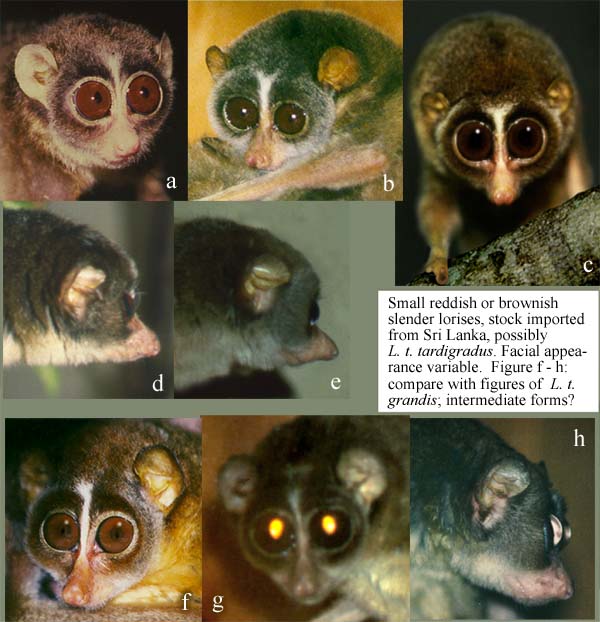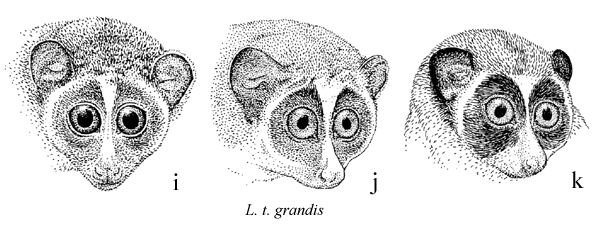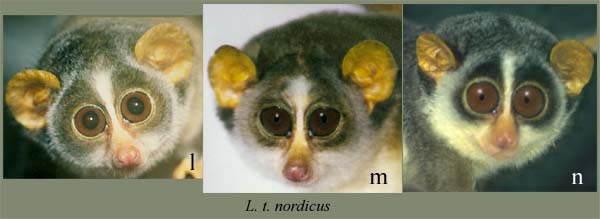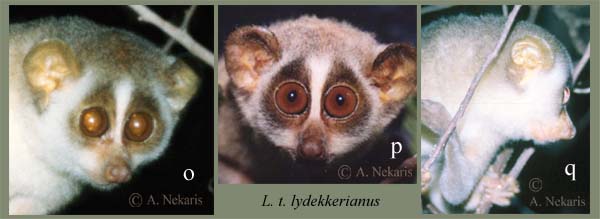
| Home |
|
|
|
d) According to Mewa Singh (pers. comm.), lorises imported from Sri Lanka are not necessarily representatives of Sri Lankan forms because smuggling of lorises between India and Sri Lanka may occur.
Because of the limited reliability of
distinguishing features, the identification key below does not
yet allow a clear identification; consideration of as many
features as possible including geographic origin, if known,
remain necessary. A verification of taxonomy, considering
ecological differences and reproductive separation, and
discovery of reliable phenotypic differences allowing to
identify live animals would be desirable for conservation.
Key to the presently known forms / subspecies within the genus Loris
1)
Hair length up to 3 cm (extreme highland form), ears completely
hidden by fur, limbs thickly furred, superficially nycticebus-like;
dorsal
colour:
earthy-brown with no reddish tinge; origin: montane rain and
mist forests of the central highland of Sri Lanka (Horton
Plains):
L. t. nycticeboides
Osman Hill, 1942.
(Existence of similar, thickly
furred forms in higher regions of India?)
Hair
shorter, ears clearly visible: 2
2)
Relatively small animals (head-body-length up to 22 cm, weight
about 85 - 135 g, foot length 35-45 cm), fur soft, velvety with
little true hair, brown, reddish or brownish-grey: rainforest
forms, L. t. tardigradus or L. t. malabaricus;
see figure 1 3
Figure 1

Relatively
small animal; fur yellowish or reddish-yellowish, reddish
circumocular patches. Ears in infants from Polonnaruwa
yellowish with a slightly pigmented rim, in other regions
pigmantation possibly more variable; see below, under 5:
Possibly juvenile L. t.
nordicus. (See under 5: large grey dry zone forms).
(Juveniles of L. t.
lydekkerianus similar? One juvenile / subadult L. t.
lydekkerianus was described as greyish-buff with chestnut
circumocular patches (Osman Hill 1933).
Recorded head-body-length 19.8-25.6 cm, foot length 38-47 mm. Distal parts of limbs well covered with fur. Dorsally dark grey, blackish or brownish-grey, in males sometimes slightly rusty on lumbar region . Throat hair pure white throughout, ventral colour pure white or only slightly buff with dark hair bases, white zone surrounding the dark circumocular patches, preauricular hair between this zone and the ears clearly darker. (In some L. t. nordicus from Polonnaruwa the circumocular patches are also surrounded by whitish hair, but then preauricular hair closer to the ears is whitish or very light grey with no marked contrast to that around the circumocular patches). Fur according to Osman Hill more coarse with a higher amount of true hair than in the more soft, velvety fur of the other forms which mainly consists of woolly hair. Photos show animals with a peculiar facial appearance (heart-shaped face with the appearance of a long muzzle): see figure 2. (A facial appearance as in L. t. grandis is also found in some small reddish specimens imported from Sri Lanka; see figure 1 f - h; see below, under 6 a, possible intermediate form).
(Features above mainly based on Osman Hillīs data. According to Goonan et al., 1995 and Groves 1998 examined skins were said to be indistinguishable from L. t. nordicus skins)
L.
t. grandis Hill and Phillips, 1932, Highland slender
loris.
Figure 2

Recorded
head-body-length 20.5-26 cm, foot length 45-56 mm, weight
usually more than 220 g in adults; fur soft, grey,
yellowish-grey, grey-brown, buff or dirty deep fawn (in
subadults occasionally with a slightly reddish forehead):
large grey dry zone
subspecies, L. t. nordicus or L. t. lydekkerianus;
see under 5, 6b.
Small rainforest slender lorises:
3)
Origin: India; head-body-legth 18 - 22 cm (weight data
insufficient, 170 g mentioned), foot length 44-45 mm, throat
hair buff throughout (hair bases coloured like tips), ventral
colour buff or dirty white:
L. t. malabaricus
Wroughton, 1917, Malabar slender loris.
(Throat hair colour:
difference to L. t. tardigradus? But see under 7 a). The
distribution area of this form includes lowland and highland
regions; density and length of fur might differ.
4)
Origin: Sri Lanka; head-body-length 18.2-20.6 mm, reported
weight about 85 - 142 g, foot length 35-44 mm; throat hair buff
with dark grey hair bases (throat hair colour: difference to L.
t. malabaricus? Some captive small reddish or brown
animals belonging to stock from Sri Lanka show an entirely white
throat, see under 6a). Ventral colour buff or yellowish,
preauricular hair grey, never white, velvety fur with a minimum
of true hair, distal parts of limbs sparsely haired or hairless:
L. t. tardigradus Linnaeus, 1758, Slender loris (see
figure 1 a - h).
5) Large grey dry zone forms:
Origin:
Sri Lanka. Head-body-length in wildcaught animals 20.5 - 23.8
cm, in large captive-bred animals up to 26 cm. Weight, 198 - 360
g; in wildcaught animals from Polonnaruwa 228 - 287 g (566-679.2
g for Wilachchiya animals probably erroneous) ; foot length
42-55 mm. Ear pigmentation possibly variable, yellow ears; in a
population of L. t. nordicus from Polonnaruwa with
unpigmented yellow ears, juveniles with pigmented brown ear
rims; according to Osman Hill black ears (erroneous?). Bases of
ventral hair usually with a grey base (in some specimens from
Polonnaruwa, hair at least in the median part of ventral side
white throughout or with very light grey, almost white bases),
lowland form with thin fur on dostal parts of limbs. In
captivity non-seasonal breeder.:
L. t. nordicus
Hill, 1933, Northern Ceylonese slender loris
(but see below, 6 b: no
difference between L. t. nordicus and L. t. grandis?).
Figure 3

Origin:
India. Head-body-length 22.3 - 26.3 cm,weight 226.8 - 346.6 g,
foot length 45 - 57.5 mm. Ears dark or with a dark rim (at least
no information about populations with unpigmented ears has been
found); bases of ventral hair usually without, seldom with a
tiny grey base. Distribution area including lowland and highland
regions, local differences in length and density of fur seem
possible. Evidence for seasonal breeding both in captivity and
in the wild: L. t. lydekkerianus Cabrera, 1908,
Mysore slender loris.
Figure 4

Photos: Anna Nekaris
6) Possibly existing intermediate forms and possible local variations:
6 a) Intermediate forms between L. t. grandis and the lowland forms of Sri Lanka are reported from the wild, intermediate tardigradus / grandis forms for instance occurring in the hills near Kandy (Phillips, 1935). Wildcaught specimens of unknown origin, imported from Sri Lanka, resembled L. t. tardigradus with regard to small size and the lack of a white zone around the circumocular patches, but showed an entirely white throat and the facial appearance as in L. t. grandis (with a "long muzzle", see figure 1 f - h).
6
b) Difference between L. t. grandis and and the
adjacent lowland form L. t. nordicus: Osman Hill
describes differences whereas, according to Goonan et al., 1995,
no differences between preserved skins and skulls of L. t.
grandis and L. t. nordicus in the Natural History
Museum, London, were found. A white throat and white zone around
the dark circumocular patches are not only found in L. t.
grandis, but also in some L. t. nordicus from
Polonnaruwa; in the latter, however, preauricular hair behind
such a white rim is not clearly darker, but also whitish or very
light grey. In two live grey Sri Lankan lorises kept in Adelaide
(exact origin of both unknown), phenotypic and karyological
differences were found (Goonan et al., 1995). The conclusion in
Goonan et al. from these findings was that L. t. nordicus
and L. t. grandis probably belong to one subspecies of
grey lorises, but that some local differences may still be
present. If both forms were identical, L. t. nordicus
would be a synonym for the older name L. t. grandis.
|
Lorises and pottos: species,
subspecies, local populations
Preliminary draft; H. Schulze, B. Meier, H.
Fitch-Snyder
|
Last
amendment: 23. July 2001
|